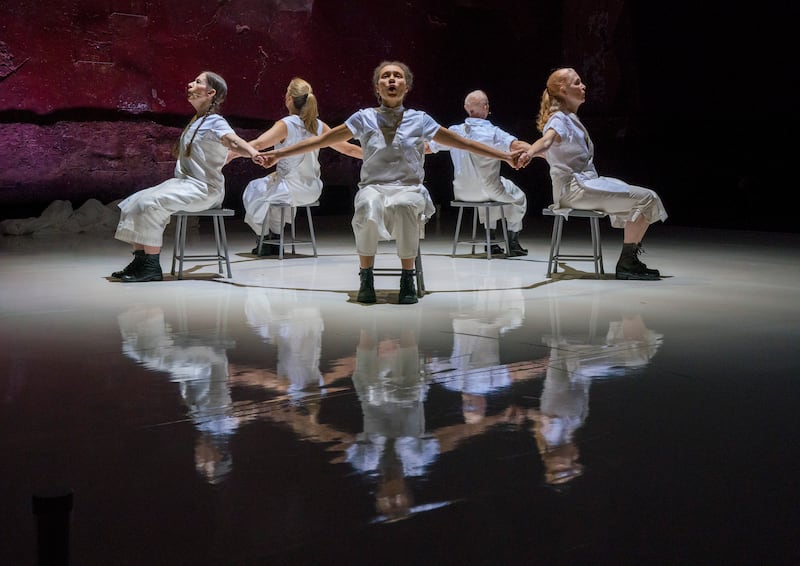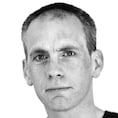To hear Meredith Monk sing is to experience the human voice at its most mind-blowing and horizon-expanding. The New York-born performer and composer has, across a dazzling 60-year career, reinvented the art of vocalisation from the ground up and the inside out. Her repertoire of howls, chirrups, whispers and incantations is both hypnotic and frightening. She exists at the outermost extremes of art – yet her work is characterised by an old-fashioned American wholesomeness and a fierce desire to connect.
“I’m trying to do music that is going to feed people. Feed their spirits, their minds and their hearts. I’m trying to make music that reflects the richness each of us has as human beings,” says Monk, who is 81, from her loft apartment in Tribeca, in Lower Manhattan. “We have our intellectual centre, our emotional centre, we have our spiritual centre, we have our physical centre. I’m trying to make music that acknowledges the richness of my listeners.”
Her fans include some of music’s great innovators. Björk, and David Byrne of Talking Heads, are among those who have spoken about the power of her music – “those precisely calibrated wails from the back of the throat, those resonant clicks and breaths and sighs”, as the New Yorker magazine put it.
She has performed all over the world – yet rarely in Ireland. A much-anticipated date at the National Concert Hall in Dublin next week will be her first here since an October 2001 appearance at the city’s long-shuttered SFX (a sort of parish hall crossed with a Stygian fleapit). But, if an infrequent visitor, she lights up at the thought of returning to Ireland.
READ MORE
“What I love about Ireland is that there is still a belief in magic,” she says. “I believe in magic, too. I really do. I’m getting teary talking to you about it. Your tradition – I listen to [the late poet, philosopher and author] John O’Donohue. [He] has a lot has affirmation of the way I feel about things. Your tradition of knowing there is an underlying magic underneath everything is so powerful. It is something to affirm all the time.”

Monk’s music is not for the faint of heart. In the 1970s she was lumped in with crowd-pleasing minimalists such as Philip Glass and Steve Reich. Yet her compositions are far more experimental.
Her 1983 album, Turtle Dreams, for instance, drew on the imagined internal life of her pet three-toed box turtle, Neutron. In an accompanying stage adaptation, Monk and a trio of collaborators performed an interpretive dance while staring at the audience with unblinking intensity. You can watch it on YouTube: it is mind-expanding and terrifying.
The concert hall is Monk’s natural habitat. She has been commissioned by Carnegie Hall and by the minimalist ensemble the Kronos Quartet, while Houston Opera sought her out to write Atlas: An Opera in Three Parts.
And yet the classical world has never entirely known what to make of Monk. Many of her biggest fans come from alternative music. The indie musician Damon Krukowski, of Galaxie 500 and Damon and Naomi, compared listening to Monk to reading Kafka. Björk coproduced a documentary about Monk and has covered her 1981 composition Gotham Lullaby in concert. In a 2005 conversation with Monk, the Icelandic artist arrived with a notepad full of questions for the composer and explained that encountering Monk’s music at the age of 16 had made her want to become a singer.
The love flows in both directions. “I love Radiohead. I love those guys. Thom Yorke, I feel very close to his work. David [Byrne], I’ve always loved. Björk is a great spirit and a fine musician.”
From a distance, she also appreciated the technique and fortitude of Sinéad O’Connor, an artist who approached singing the way an actor might chew on a challenging dramatic role, giving themselves to it utterly and unquestioningly. “A beautiful singer,” says Monk, who adds that O’Connor’s voice was a “beautiful instrument”.
Monk was born in New York in 1942. Her father was a businessman. Her mother came from a long musical lineage: Monk’s maternal grandfather had been a Russian-Jewish bass-baritone, her maternal grandmother a German-Jewish concert pianist.
Artistically, Monk’s early experiences were in dance. She had been diagnosed at the age of three with strabismus, a visual disorder that used to be known as a squint. Her parents were encouraged to sign her up for classes in the Dalcroze method, which teaches the visually impaired to interact with the world around them through dance.
Those early experiences stayed with her. In 1961 she appeared off-Broadway as a solo dancer. By the time she graduated from Sarah Lawrence College, in 1964, and threw herself into the New York downtown scene, she had come to see sound and movement as intertwined. That philosophy remains central to her music and will be on display at the NCH, where she will be joined by her Vocal Ensemble, the singer-dancers Katie Geissinger and Allison Sniffin.
There was a male western European way of making music, which I never was that interested in
Monk had already found her place as the perennial outsider in contemporary music when Turtle Dreams had its premiere. She was the eternal voice in the wilderness – a luminescent free spirit bound by no rules other than her own. It is a status with which she remains entirely at ease. She is a composer who engages mainly with the human voice but specialises in nonverbal communication. The mainstream was never going to embrace her. Far from feeling rejected, she was happy to keep her distance.
“I was proposing a different way of making music,” she says, explaining that she had little patience with the old patriarchal methods of composition. “At that time, there was a male western European way of making music, which I never was that interested in. I was always interested in integrating the body and the voice. I was trying to uncover the primal world of utterance. A full palette of emotion.”
Monk has always gone where some musicians might fear to venture. “Other people were trying to cut off from that [lyric-free singing] – for very good reasons. That [conventional] way of thinking about things is perfectly fine. But there were some people who didn’t see how rigorous my work was. And that it was rigorous. It also was a different way of thinking about music. The people that gave me a lot of encouragement at the beginning of my music exploration were the jazz guys. They were, like, ‘Girl, you’ve got time, you’ve got a pitch, you’ve got your instrument. Just go for it.’”
In Dublin, she and her ensemble will perform pieces from across her career. It is a repertoire that, despite its abstractness, has often grappled with the big themes of the day. In 1991, when many of her gay friends were dying of Aids, she poured her sadness and anger into her New York Requiem. A decade previously, she wrestled with the cold war and the prospect of nuclear annihilation through the science-fiction opera The Games.
This world is just overwhelming. The ignorance of this world. How do you work with that? The way I work with it is I continue to believe in the healing power of art
Still, for all its specificity, her music has never dated. That’s because the underlying emotions that she explores are constant and universal. Fear, wonder, dread: we live them all in our own lives every day. As does Monk, who has watched the return of Donald Trump with rising horror.
“This world is just overwhelming. The ignorance of this world,” she says. “How do you work with that? The way I work with it is I continue to believe in the healing power of art.”
Her life could easily have taken a different path. “There was a certain point in the 1960s I was in a band called The Inner Ear. But I was making my own work. I was, like, ‘I don’t want to take the place of someone who wants to be a rock singer. I know I’m not going to dedicate my life to that form.’ I was more interested in making my own forms.”
The showmanship of rock music isn’t for her, she says. There will be magic – endless quantities of it – when she performs in Dublin. But it will be entirely of her creation, not something conjured by flashing lights or a video screen. To her, art comes from an elemental place beyond mere spectacle.
“When I see Björk’s concerts, she has to bring high production because that’s what people expect. I said to her, ‘I would love to see you and five musicians and no production.’ I realise that people expect that high production value. It’s really hard. I just wanted to make my own world.”
Meredith Monk and Vocal Ensemble perform at the National Concert Hall, Dublin 2, on Tuesday, February 13th



















